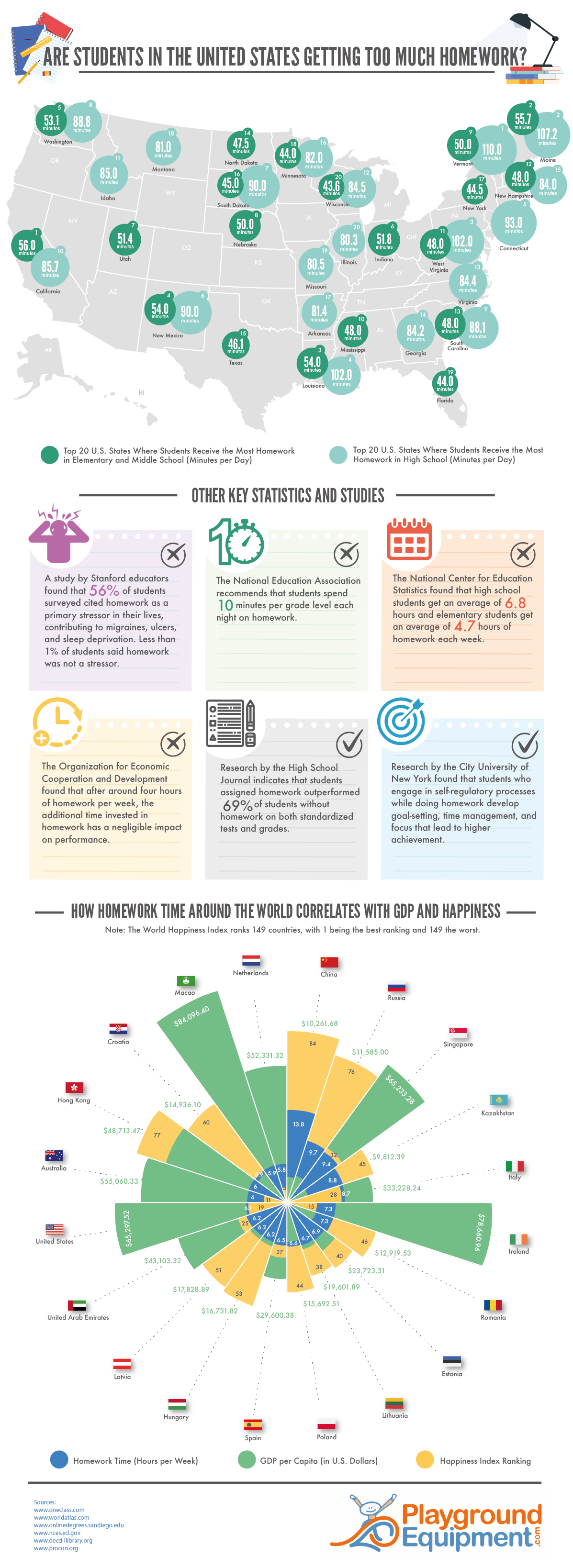Are Students in the United States Getting Too Much Homework?
How much homework is too much? Both the National Education Association and the National PTA support the standard of ten minutes of homework per grade level and ensuring that there is a general limit to how much time students spend studying after school. While many school districts have adopted these guidelines, many parents, teachers, and students themselves have spoken out about the stress and lack of free time caused by too much homework. There is a growing movement that calls for giving students more freedom to play, explore, socialize, and discover what excites them. However, many believe that homework and studying are crucial tools for academic success and character development. This infographic from Playground Equipment takes a data-driven approach to homework in America and homework around the world to help gain a more balanced perspective.
Click to view the full-size image
Embed this image on your site:
Here are the top 20 U.S. states with the most homework in elementary and middle school in minutes per day:
- California: 56 minutes
- Maine: 55.7 minutes
- Louisiana: 54 minutes
- New Mexico: 54 minutes
- Washington: 53.1 minutes
- Indiana: 51.8 minutes
- Utah: 51.4 minutes
- Nebraska: 50 minutes
- Vermont: 50 minutes
- Mississippi: 48 minutes
- West Virginia: 48 minutes
- New Hampshire: 48 minutes
- South Carolina: 48 minutes
- North Dakota: 47.5 minutes
- Texas: 46.1 minutes
- South Dakota: 45 minutes
- New York: 44.5 minutes
- Minnesota: 44 minutes
- Florida: 44 minutes
- Wisconsin: 43.6 minutes
Here are the top 20 U.S. states with the most homework in high school in minutes per day:
- Vermont: 110 minutes
- Maine: 107.2 minutes
- West Virginia: 102 minutes
- Louisiana: 102 minutes
- Connecticut: 93 minutes
- New Mexico: 90 minutes
- South Dakota: 90 minutes
- Washington: 88.8 minutes
- South Carolina: 88.1 minutes
- California: 85.7 minutes
- Idaho: 85 minutes
- Wisconsin: 84.5 minutes
- Virginia: 84.4 minutes
- Georgia: 84.2 minutes
- New Hampshire: 84 minutes
- Minnesota: 82 minutes
- Arkansas: 81.4 minutes
- Montana: 81 minutes
- Missouri: 80.5 minutes
- Illinois: 80.3 minutes
What Countries Give the Most Homework?
If you are curious about what countries have the most homework, we have compiled data to provide insight into how homework around the world is incorporated into the daily routines of students. Here are the top ten countries where children spend the most time on homework:
- China: 13.8 hours weekly
- Russia: 9.7 hours weekly
- Singapore: 9.4 hours weekly
- Kazakhstan: 8.8 hours weekly
- Italy: 8.7 hours weekly
- Ireland: 7.3 hours weekly
- Romania: 7.3 hours weekly
- Estonia: 6.9 hours weekly
- Lithuania: 6.7 hours weekly
- Poland: 6.6 hours weekly
Pros and Cons of Homework
Is homework helpful? Or is homework harmful? There’s plenty of research that supports both sides. Here are a few pros and cons of homework to consider:
- Con: A study by Stanford educators found that 56% of students surveyed cited homework as a primary stressor in their lives, contributing to migraines, ulcers, and sleep deprivation. Less than 1% of students said homework was not a stressor.
- Con: The National Center for Education Statistics found that high school students get an average of 6.8 hours and elementary students get an average of 4.7 hours of homework each week. This is more than what is recommended by experts.
- Con: The Organization for Economic Cooperation and Development found that after around four hours of homework per week, the additional time invested in homework has a negligible impact on performance.
- Pro: Research by the High School Journal indicates that students assigned homework outperformed 69% of students without homework on both standardized tests and grades.
- Pro: Research by the City University of New York stated that students who engage in self-regulatory processes such as homework develop goal-setting, time management, and focus skills that lead to higher achievement.
This infographic is brought to you by Playground Equipment Commercial Playgrounds.
Edited by: Ben Thompson


